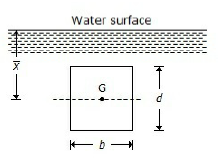A water tank contains 1.3 m deep water. The pressure exerted by the water per metre length of the tank is
2.89 kN
8.29 kN
9.28 kN
28.9 kN
Correct Answer :
B. 8.29 kN
Related Questions
The difference of pressure between the inside and outside of a liquid drop is
p = T × r
p = T/r
p = T/2r
p = 2T/r
The density of water is 1000 kg/m3 at
0° C
0° K
4° C
20° C
The water pressure per metre length on a vertical masonry wall of dam is (where w = Specific weight of the liquid, and H = Height of the liquid)
wH/2
wH
wH2/2
wH2/4
The surface tension of mercury at normal temperature is __________ that of water.
Same as
Lower than
Higher than
None of these
The unit of viscosity is
Metres² per sec
kg-sec/metre
Newton-sec per metre²
Newton-sec per meter
For manometer, a better liquid combination is one having
Higher surface tension
Lower surface tension
Surface tension is no criterion
High density and viscosity
The dynamic viscosity of the liquid __________ with rise in temperature.
Remain unaffected
Increases
Decreases
None of these
If a body floating in a liquid occupies a new position and remains at rest in this new position, when given a small angular displacement, the body is said to be in __________ equilibrium.
Neutral
Stable
Unstable
None of these
Total pressure on a lmxlm gate immersed vertically at a depth of 2 m below the free water surface will be
1000 kg
4000 kg
2000 kg
8000 kg
When a body, floating in a liquid, is given a small angular displacement, it starts oscillating about a point known as
Centre of pressure
Centre of gravity
Centre of buoyancy
Metacentre
The buoyancy depends on
Mass of liquid displaced
Viscosity of the liquid
Pressure of the liquid displaced
Depth of immersion
True one-dimensional flow occurs when
The direction and magnitude of the velocity at all points are identical
The velocity of successive fluid particles, at any point, is the same at successive periods of time
The magnitude and direction of the velocity do not change from point to point in the fluid
The fluid particles move in plane or parallel planes and the streamline patterns are identical in each plane
In the case of steady flow of a fluid, the acceleration of any fluid particle is
Constant
Variable
Zero
Zero under limiting conditions
In order to increase sensitivity of U-tube manometer, one leg is usually inclined by angle θ. Sensitivity of inclined tube to sensitivity of Utube is equal to
Sinθ
1/Sinθ
Cosθ
1/Cosθ
Capillary action is due to the
Surface tension
Cohesion of the liquid
Adhesion of the liquid molecules and the molecules on the surface of a solid
All of the above
To avoid an interruption in the flow of a siphon, an air vessel is provided
At the inlet
At the outlet
At the summit
At any point between inlet and outlet
The angle of contact in case of a liquid depends upon
The nature of the liquid and the solid
The material which exists above the free surface of the liquid
Both of die above
Any one of the above
The absolute pressure is equal to
Gauge pressure + atmospheric pressure
Gauge pressure - atmospheric pressure
Atmospheric pressure - gauge pressure
Gauge pressure - vacuum pressure
Two dimensional flows occurs when
The direction and magnitude of the velocity at all points are identical
The velocity of successive fluid particles, at any point, is the same at successive periods of time
The magnitude and direction of the velocity do not change from point to point in the fluid
The fluid particles move in plane or parallel planes and the streamline patterns are identical in each plane
A vertically immersed surface is shown in the below figure. The distance of its centre of pressure from the water surface is 
(bd²/12) + x
(d²/12 x) + x
b²/12 + x
d²/12 + x
Alcohol is used in manometers because
It has low vapour pressure
It is clearly visible
It has low surface tension
It can provide longer column due to low density
The tangential velocity of the water element having a free vortex is
Directly proportional to its distance from the centre
Inversely proportional to its distance from the centre
Directly proportional to its (distance)2 from the centre
Inversely proportional to its (distance)2 from the centre
The surface tension of mercury at normal temperature compared to that of water is
More
Less
Same
More or less depending on size of glass tube
Coefficient of discharge Cd is equal to (where Cc = Coefficient of contraction, Cv = Coefficient of velocity, and Cr = Coefficient of resistance)
Cc × Cv
Cc × Cr
Cv × Cr
Cc/Cr
The pressure in the air space above an oil (sp. gr. 0.8) surface in a tank is 0.1 kg/cm. The pressure at 2.5 m below the oil surface will be
2 metres of water column
3 metres of water column
3.5 metres of water column
4 m of water column
The intensity of pressure at any point, in a liquid, is __________ to the depth of liquid from the surface.
Equal
Directly proportional
Inversely proportional
None of these
A hemispherical tank of radius (R) has an orifice of cross-sectional area (a) at its bottom and is full of liquid. The time required to empty the tank completely is
14π R1/2/15Cd × a √(2g)
14π R3/2/15Cd × a √(2g)
14π R5/2/15Cd × a √(2g)
14π R7/2/15Cd × a √(2g)
The centre of gravity of the volume of the liquid displaced by an immersed body is called
Centre of gravity
Centre of pressure
Metacentre
Centre of buoyancy
The ratio of the inertia force to the elastic force is called
Reynold's number
Froude's number
Weber's number
Mach number
Metacentric height is the distance between the metacentre and
Water surface
Center of pressure
Center of gravity
Center of buoyancy
